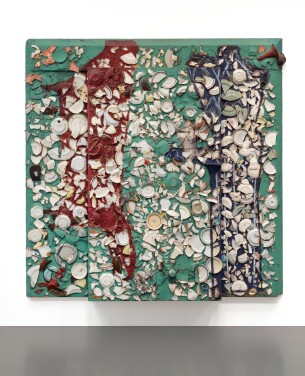Works by Julian Schnabel at Sotheby's
Julian Schnabel Biography
American painter and filmmaker Julian Schnabel synthesized the postmodern interests in earlier artistic movements such as German Expressionism and Abstract Expressionism, with a heightened sense of experimentation with materiality. His works from the late 1970s and 1980s, alongside those of Jean-Michel Basquiat and Eric Fischl, contributed to the development of American Neo-Expressionism. He is a leading contemporary American artist, whose popularity has exponentially grown with his particular public persona.
Born in Brooklyn in 1951, Schnabel moved with his family to Texas in 1965; he completed his BFA at the University of Houston, before completing the ISP (Independent Study Program) at the Whitney Museum of American Art from 1973 to 1975. By 1979 he already experienced considerable success; the Mary Boone Gallery held his first solo show, from which all his works were sold in advance. Throughout the 1980s, his paintings were hailed as major successes by the art world, for their expression and wide range of material. Schnabel began directing and producing films for which he has received impressive awards. His first feature-length film, Basquiat, presented the life of his late friend and colleague Jean-Michel Basquiat; The Diving Bell and the Butterfly won best director at the 2007 Cannes Film Festival. Schnabel has already left his mark on the architecture of New York City, with his Palazzo Chupi, an iconic pink palazzo in the West Village which he converted from horse stables to luxury condominiums in which he now resides.
Despite – or in part due to – his controversial persona, his career embodies the experimentation, fame and self-consciousness of the postmodern period. Schnabel’s works can be found in the permanent collections of major museums around the world including the Metropolitan Museum of Art, the Museum of Modern Art, the Whitney Museum, Reina Sofia, the Tate Modern and the Centre Georges Pompidou, among others.












